Exploring Switchblade Kites in Kiteboarding

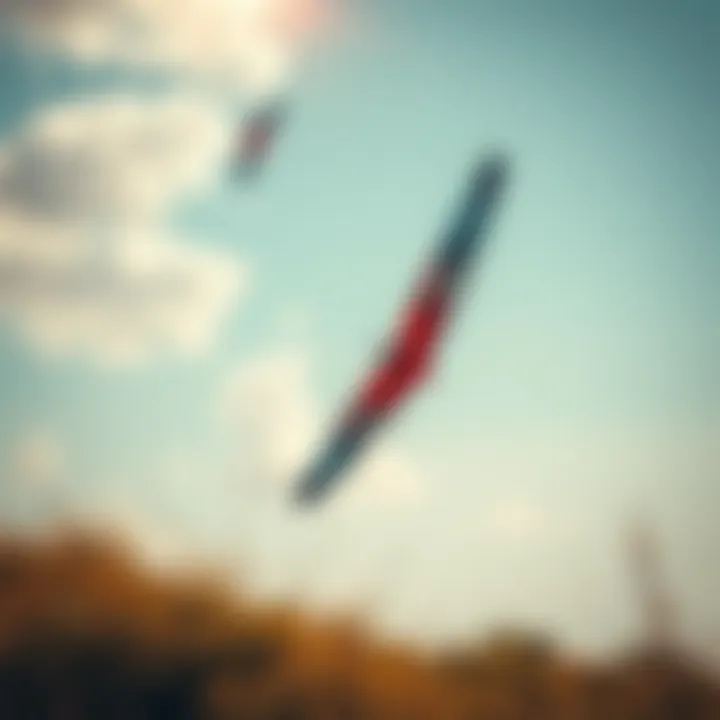
Intro
Understanding the intricacies of switchblade kites can be likened to mastering a finely tuned instrument. Each component, from the canopy to the lines, plays a pivotal role in how the kite performs on the water. This article unfolds the layers of design, performance, and practicality connected with these kites, which are favored among kiteboarders for their reliability and adaptability in diverse conditions.
Kiteboarding itself is a dance with wind and water, a sport that requires not just skill but also a deep understanding of the gear used. Switchblade kites, made for varying wind conditions, have gained traction among both novices and seasoned kiteboarders. Their design allows for a smooth ride, offering ease in control and maneuverability. This article aims to elucidate the nuances of these kites, giving readers keen insights that can transform their kiteboarding adventures, whether they are just taking off or soaring like pros.
Next, we shall dive into the Gear and Equipment necessary for any kiteboarder embarking on their journey.
Prologue to Switchblade Kites
Switchblade kites have made a noteworthy impact in the world of kiteboarding, offering a unique blend of performance, adaptability, and user-friendliness. Understanding the mechanics and benefits of these kites is essential for both new and experienced riders seeking to elevate their kiteboarding experience.
These kites stand out for their versatility. They cater to a diverse range of conditions and riding styles, making them a favored choice among enthusiasts. Moreover, their ability to perform well across various wind conditions acts as a significant advantage, enabling riders to fully enjoy their time on the water without constantly swapping equipment.
Furthermore, newcomers to kiteboarding can find a comfortable introduction through switchblade kites, as they are designed with stability and ease of control in mind. This feature allows learners to focus more on enhancing their skills and less on battling against unpredictable kite behavior.
Understanding the Concept of Switchblade Kites
The name "switchblade" is quite descriptive of what these kites aim to achieve: a well-balanced mix of power and control. Unlike some kites that excel in certain conditions but falter in others, switchblade kites are engineered for performance in a broader spectrum of environments. At their core, the concept revolves around an innovative design that incorporates advanced materials and structural integrity, optimizing functionality and safety during use.
These kites typically feature a fuller profile which enhances lift, allowing them to soar high while maintaining a smooth descent. Riders often find that this kite type provides a solid pull, enabling them to ride with confidence whether they are carving through waves or executing jumps.
Historical Development and Evolution
The evolution of switchblade kites traces back to significant technological advancements within the sport of kiteboarding. Initially, kites were relatively simple in design—limited by rudimentary materials and basic shapes. However, as kiteboarding gained popularity, manufacturers began to experiment with various designs, ultimately leading to the emergence of more intricate models.
In particular, the shift towards durable fabrics like ripstop nylon played a crucial role in enhancing kite longevity and performance. Coupled with refined aerodynamic shapes, this development marked a turning point in kite design. As kiteboarding grew, so did the complexity of the kites themselves, giving rise to the versatile switchblade kite—a product that reflected the needs and wants of a maturing sport. The introduction of switchblade models broadened the options available to kiteboarders, offering them tools that not only perform well but also foster a more enjoyable experience on the water.
In summary, understanding switchblade kites is indispensable for any kiteboarding enthusiast keen on enhancing their skills and experiences. Their unique blend of stability, performance, and user-friendliness makes them a staple in the kiteboarding community. The historical journey that led to their creation provides valuable context for their design and usage, illuminating their significance in modern kiteboarding.
Key Features of Switchblade Kites
When it comes to kiteboarding, understanding the characteristics of switchblade kites is essential for enhancing performance and ensuring a thrilling experience. The features of these kites play a pivotal role in how they handle the wind, how responsive they are, and how well they suit different rider preferences. Let's delve deep into what makes switchblade kites a popular choice among enthusiasts.
Design Elements
Canopy Construction
The canopy construction of a switchblade kite significantly influences its overall performance. Typically, these canopies are crafted from high-durability materials like ripstop nylon, which provides a balance of strength and lightness. The key characteristic of this construction is its resistance to tearing, ensuring that the kite remains intact even under vigorous conditions. This makes it a beneficial choice for riders who often find themselves in challenging winds.
A unique feature of this construction is the double-layered design found in many switchblade kites. This provides enhanced durability, but it can also add slight weight, affecting the kite's agility. However, riders often find the trade-off worth it, as the extra strength translates to fewer repairs over time, and provides peace of mind when tearing through the waves.
Leading Edge Design
The leading edge design of switchblade kites is crucial for their aerodynamics. Most have a high-roach, which allows them to slice through the air with minimal drag. The key characteristic here is the smooth curvature, which helps to maintain lift even in fluctuating wind conditions. This makes switchblade kites highly versatile.
A notable feature of this design is its ability to generate power without excessive pulling. While riders appreciate the power, they also prefer not to feel overpowered by the kite. This design strikes a balance, allowing for impressive jumps and maneuvers while minimizing fatigue on the rider.
Bridle Systems
Bridle systems play a significant role in how switchblade kites operate. These systems determine how the kite positions itself in the wind and influence its stability. The key characteristic of modern bridle systems is their depower capability. This allows the rider to adjust the kite's performance according to their skill level and the wind conditions.
One unique aspect of the bridle system is the two-point connection that offers efficient load distribution. This configuration not only boosts stability but also enhances responsiveness. For both beginners and advanced kiteboarders, this integration can be a game-changer, ensuring a safe and controlled ride even in gustier winds.
Material Composition
Durability
Durability is a critical aspect of switchblade kites, as they must withstand various environmental challenges. The material choices often include tear-resistant fabrics that not only protect against abrasion but also maintain performance in challenging conditions. The key characteristic here is the long-lasting life span which these materials provide, reducing the frequency of replacements.
A unique feature of durable kites is their resistance to UV light degradation. Riders can enjoy the sun without worrying about the material breaking down over time. However, users must still take care during storage, as exposure to harsh conditions over extended periods can still affect performance.
Weight Considerations
Weight is another pivotal component in the performance of switchblade kites. The ideal weight allows for optimal lift while providing control during aggressive maneuvers. The key characteristic of lightweight materials is that they allow for easy handling during launches and landings.
Kites that use lighter fabrics often tend to perform better in light wind conditions. This can be of significant benefit for riders who frequent areas with variable winds. Yet, the trade-off comes in potential vulnerability to damage, so care and maintenance are crucial.
Environmental Impact
The environmental impact of kite materials cannot be overlooked in the current climate aware society. Many reputable manufacturers have started to explore more sustainable options in their production processes, such as using biodegradable materials. The key characteristic of this approach is a commitment to reducing waste in kiteboarding.
A unique aspect of this trend is the increased demand for products that contribute to a circular economy. While these options may sometimes come at a premium price, riders often view the investment favorably, especially when considering both performance and environmental stewardship. Choosing eco-friendly kites can make a significant difference in the long span of kiteboarding's future.
Performance Characteristics
Performance characteristics of switchblade kites play a pivotal role in understanding their operational advantages and how they cater to different riders. These aspects shape not only the kite's performance but also directly influence the rider's experience. An in-depth look into flying characteristics and handling control reveals essential elements like wind range, stability, response time, bar pressure, steering dynamics, and depower options.
Flying Characteristics
Wind Range
The wind range of a switchblade kite fundamentally determines its versatility. Each kite model has a specific range in which it operates optimally. This means that from light to strong winds, the kite remains responsive and enjoyable. The key takeaway here is that kiteboarders can ride across various conditions without needing multiple kites. A broader wind range enhances the usability of a kite for all skill levels, making it a popular choice among enthusiasts. However, too much wind can lead to an uncontrollable kite, making it crucial to understand your limits and the kite’s specifications.
Stability
Stability is paramount for any rider; it significantly impacts comfort and confidence while flying. A stable switchblade kite allows for smoother rides and decreases the likelihood of erratic movements. This predictable behavior of the kite fosters trust in less experienced riders while being just as important for seasoned users who might be executing more advanced maneuvers. The trade-off, however, might come in terms of maneuverability, as some ultra-stable designs can feel a bit sluggish in response to demands for rapid changes in direction.
Response Time
Quick response time is a fundamental characteristic that allows riders to maintain control of their kites during varying conditions. A kite that responds swiftly to steering inputs offers a more engaging and dynamic riding experience. That being said, a kite with too sensitive a response can be overwhelming for beginners, leading to poor handling and possible crashes. Therefore, the challenge lies in finding the right balance; a kite must be responsive enough to ensure excitement but not so quick that it becomes difficult to manage.
Handling and Control
Bar Pressure
The bar pressure associated with a switchblade kite provides critical feedback to riders. A kite with moderate bar pressure enables a rider to feel the kite's position and movement, making it easier to steer and control. It's considered beneficial as it allows more intuitive handling, even when conditions become challenging. However, excessive bar pressure can lead to fatigue during longer sessions, which could discourage some riders. Thus, selecting an appropriate bar pressure for your personal comfort level is essential.

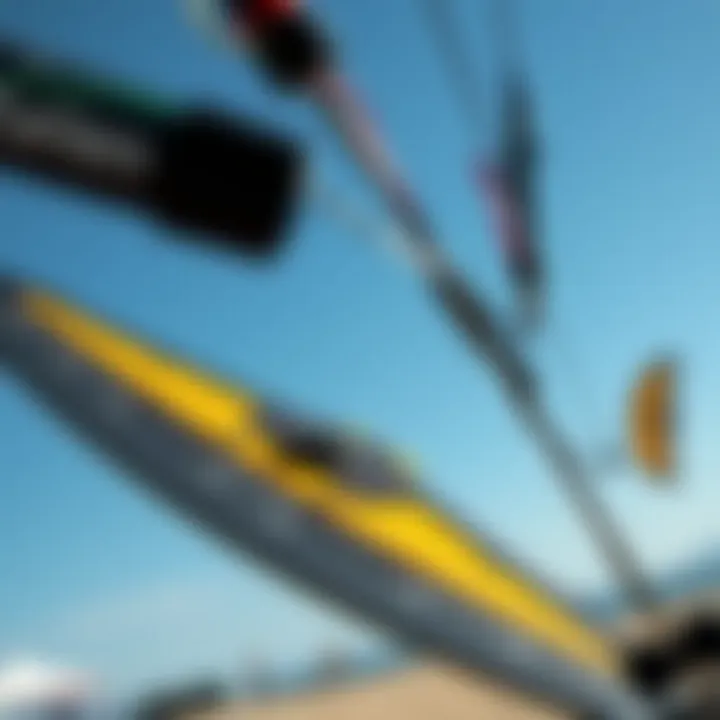
Steering Dynamics
Steering dynamics shape how responsive a kite is when turning. This characteristic can vary widely between different models of switchblade kites. A kite that offers smooth and direct steering enhances the overall riding experience, allowing for seamless transitions between tricks and maneuvers. Conversely, poor steering dynamics can render a kite cumbersome and frustrating to navigate. A clear understanding of this aspect can greatly elevate a kiteboarder's confidence and skill development over time.
Depower Options
Depower options give riders the ability to adjust the power of the kite based on their skill level and prevailing wind conditions. Having good depower functionality means if the wind picks up unexpectedly, the rider can reduce the power without the need to change kites. This feature caters to safer riding, especially for less experienced boarders navigating varied environments. However, too much depower can lead to a loss of control, so understanding how to balance this feature with your performance goals is crucial.
"Assessing the performance characteristics of your kite is essential for a fulfilling kiteboarding experience."
In sum, the performance characteristics of switchblade kites directly influence how riders of all skill levels engage with and enjoy kiteboarding. Understanding these attributes can enhance your ride, ensuring every moment on the water is both thrilling and controlled.
Suitability for Different Kiteboarders
Choosing the right switchblade kite is crucial for kiteboarders at all levels. When we talk about suitability, it isn’t just about picking a kite; it’s about understanding how different characteristics and features cater to various skill levels. Each rider brings their own unique needs and preferences to the table.
The diverse design and application of switchblade kites makes them versatile tools that adjust well to the experience level of the user, whether a newcomer, a seasoned hobbyist, or a competition-ready athlete. We’ll dissect this more as we examine how switchblade kites can work for beginners, intermediate riders, and advanced users.
Beginners
Learning Curve
For novices, the learning curve associated with switchblade kites is often smoother than that of other types. This is due to their inherent stability and ease of handling. Beginners find that the kites behave predictably in various wind conditions, giving new riders the confidence they need to master kite basics without feeling overwhelmed. This gradual introduction to the sport enables them to progressively sharpen their skills at their own pace.
Advantages:
- Predictability: Trainees can rely on consistent performance.
- Confidence Building: Fewer surprises encourage practice and persistence.
Disadvantages:
- May not challenge more ambitious beginners who crave quick advancement in tricks and maneuvers.
Safety Features
Safety first is the motto that resonates strongly in kiteboarding. Manufacturers prioritize safety features in switchblade kites, ensuring that as many precautions as possible are integrated. From emergency release systems to depower straps that quickly reduce kite pull, these aspects are designed to minimize risks for learners.
The kites usually come with bright colors for visibility and user-friendly design that aids quick understanding of basic safety protocols.
Advantages:
- Reliable emergency systems empower new riders to focus on learning without fear.
Disadvantages:
- Some may mistakenly rely solely on safety features and neglect essential riding techniques.
User-Friendly Aspects
Finally, the user-friendly aspects of switchblade kites make them incredibly appealing to those just starting out. Intuitive controls, smaller bar pressures, and easy launch/landing techniques mean less hassle and more fun on the water. Newcomers can pick these kites up quickly, making for a more enjoyable learning experience.
Advantages:
- Empowered riders feel capable and motivated to improve.
Disadvantages:
- Over-simplification of controls may lead to complacency in learning more advanced techniques.
Intermediate Riders
Progression Techniques
With some foundational skills in place, intermediate kiteboarders look to refine their techniques, and switchblade kites offer excellent progression techniques for this purpose. These kites allow riders to explore new maneuvers while still providing that critical stability they now expect, promoting confidence when trying more challenging tricks.
Advantages:
- Encourages experimentation with jumps and spins due to stable support.
Disadvantages:
- If the kite doesn’t push their limits, some riders may plateau.
Versatile Applications
Switchblade kites are known for their versatile applications, enabling riders to utilize them across various conditions and styles, whether cruising, racing, or engaging in freestyle. This adaptability lets intermediate riders rapidly shift focus, honing different skills as they explore more about their kiteboarding preferences.
Advantages:
- Transitioning becomes less cumbersome, leading to more comprehensive skill development.
Disadvantages:
- A wider range might confuse some riders about what specialization to pursue.
Condition Adaptability
The condition adaptability of switchblade kites means they perform well in changing wind conditions. For an intermediate rider, this can alleviate worry about wind fluctuations and allow for a more carefree ride. Riders can expect the kite to handle gusts and lulls, giving them freedom to focus on their craft rather than constantly adjusting to environmental challenges.
Advantages:
- Boosts comfort and reduces the need for frequent kite switches with wind changes.
Disadvantages:
- May lead to a false sense of security, making one less wary of extreme conditions.
Advanced Users

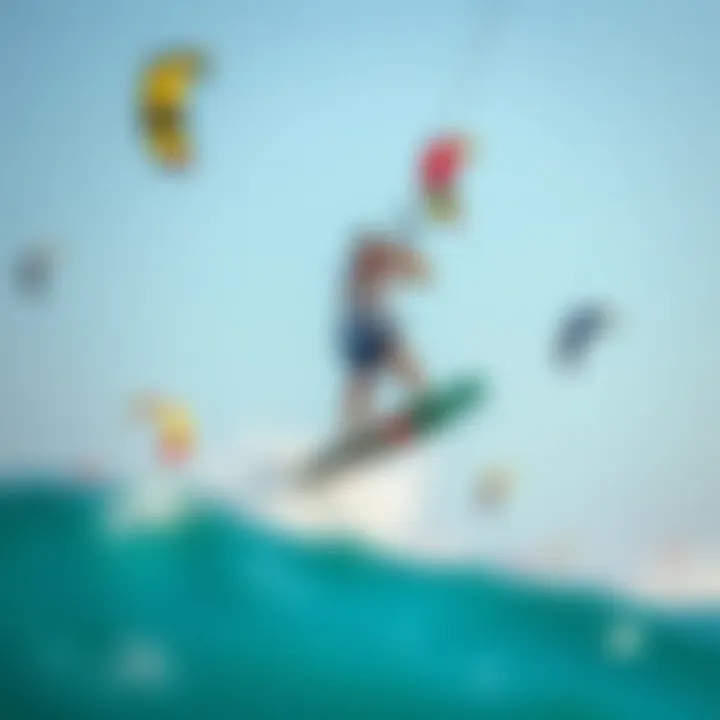
Performance Optimization
At an advanced level, kiteboarders are not just looking to ride — they crave performance optimization. Switchblade kites cater to this need with features that allow for fine-tuning of both speed and maneuverability. This effectiveness in performance can be a winning edge during competitive events or simply for pursuing personal bests.
Advantages:
- Enhanced control at high speeds for impressive tricks.
Disadvantages:
- Requires careful tuning; small misadjustments can lead to performance issues.
Freestyle Considerations
Advanced users typically venture into freestyle riding where the freestyle considerations of a kite become critical. Switchblade kites, with their strong lift capabilities, offer great support for jumps and spins. This quality helps seasoned riders not only land tricks but truly express their style in the air and on the water.
Advantages:
- Boosted aerial potential fuels creativity in performance.
Disadvantages:
- Adequate practice is essential; relying too heavily on kite features may suppress individual development.
Wave Riding Capabilities
Advanced kiteboarders often seek out waves, and the wave riding capabilities of switchblade kites play an important role here. These kites can handle the complex dynamics of open water. They remain stable even in turbulent conditions, ensuring riders have that much-needed reliability when battling waves.
Advantages:
- Excellent handling in surf translates to smoother rides.
Disadvantages:
- Skills in wave riding can take time to develop, impacting expectations for new wave riders.
By understanding the suitability of switchblade kites for various levels, riders can make informed choices that heighten their experiences — no matter if they are just starting or ready to master the art of kiteboarding.
Considerations When Choosing a Switchblade Kite
Choosing the right switchblade kite can make or break your kiteboarding experience. With various options available, it’s essential to consider several key factors to ensure that your selection aligns with your individual style and conditions. Making an informed choice allows you to maximize performance while minimizing risks. The following subsections will help you navigate the important aspects of size selection and brand comparisons, which are vital in finding that perfect kite.
Size Selection
Rider Weight
When it comes to kiteboarding, rider weight is a significant factor in how a switchblade kite performs. Kites come in various sizes, and selecting one that aligns well with your weight will enhance your overall experience. A lighter rider may find that a smaller kite gives better responsiveness and control, while heavier riders need larger kites to catch enough wind.
A key characteristic of rider weight is that it impacts how the kite behaves in the air. For example, a lighter kite might be more suitable for soaring during jumps, but it may struggle in stronger winds if the rider is on the heavier side. It's a balancing act, really; if you choose a kite that’s not appropriate for your weight, you can end up dragging in the water or, conversely, flying up too high with little control.
Selecting the optimal size for your weight isn’t just beneficial; it's critical for safety. Unique features like adjustable foils or struts can provide extra performance tweaks based on weight, ensuring that you ride safe and fun.
Local Conditions
The environment where you usually kiteboard also plays a pivotal role in the kite choice. Local conditions include wind strength, consistency, and even the type of water you'll be riding on – whether it's flat, choppy, or has waves. Understanding your local setup is essential for finding a kite that will perform best.
A key characteristic of local conditions is that they can vary widely from one spot to another. A kite that performs well in light winds might not hold up in gusty conditions, or vice versa. Especially on days with inconsistent wind patterns, having the right kite size can make it feel like you’re riding a dream or struggling against the elements.
Unique features of local conditions can also include seasonal variations, as some areas have reliable winds during the summer months while others are more varied. Adjusting your kite size based on this seasonal fluctuation can give you a significant advantage.
Intended Use
Understanding your intended use is another critical factor when selecting a switchblade kite. Are you looking to cruise leisurely, perform tricks, or tackle waves? Each application has specific requirements that can dictate which kite will serve you best.
A key characteristic of intended use is how it significantly influences what you’ll gain from your time on the water. For instance, a kite designed for freestyle maneuvers will differ from one meant for racing or wave riding. A switchblade kite used for tricks may favor low-end power for easier jumps, while a wave kite might be designed for stability and quick turns.
The unique feature of intended use means that your kite choice not only impacts performance but also the enjoyment factor. By aligning your kite selection with your riding goals, you ensure not just skill development but that your time on the water is both fulfilling and enjoyable.
Brand Comparisons
Reputation and Reliability
When looking for a switchblade kite, brand reputation and reliability become cornerstone considerations. Well-established brands are often accompanied by a legacy of performance and innovation, ensuring that you're getting a kite that stands the test of time.
A key characteristic of reputation is that it often reflects the trust users have in a brand's products. Established brands frequently invest in rigorous testing and development, enhancing the overall safety and functionality of their kites. If a brand is known for consistently producing reliable kites, it can save you from making a regretful choice down the line.
The unique feature of a well-regarded brand allows for better assurance with your investment. Lesser-known brands may offer enticing features at a lower price point, but the risk often comes with uncertainty about durability and performance over time.
Technical Support
Equally important is the level of technical support provided by manufacturers. Having access to responsive customer service and comprehensive support materials can significantly ease the learning curve for novice kiteboarders and offer essential assistance for more experienced riders facing technical issues.
Key characteristic of technical support is the peace of mind it provides. Reliable customer service can turn what might feel like a nightmare of troubleshooting into a manageable solution. Whether you need help with setup or finding replacement parts, good support can simplify your experience with your switchblade kite.
Unique features such as online tutorials or community support forums can further strengthen the technical backing of a brand, making it easier for kiteboarders to improve their skills and address any issues they encounter.
User Reviews
Lastly, there's a significant value in exploring user reviews when selecting your switchblade kite. Real-world experiences can carry more weight than any marketing material, offering genuine insights into performance, durability, and user satisfaction.
Key characteristic of user reviews is that they originate from actual kiteboarders who provide firsthand accounts of their experiences. This can range from the kite’s performance in various wind conditions to insights about comfort and control during rides.
Reading through reviews can help you avoid the pitfalls of a poor purchasing decision. However, it’s essential to look for patterns in feedback to distinguish between individual bias and legitimate concerns.
The unique feature of user reviews is the community aspect, allowing you to connect with other kiteboarders and learn from their successes and missteps. Plus, it adds a layer of social proof, validating that the choice you’re considering aligns with what others have found beneficial or problematic.
Kiteboarding Techniques with Switchblade Kites
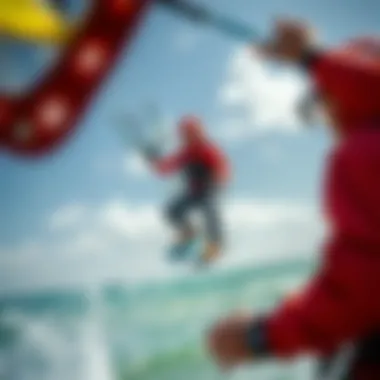
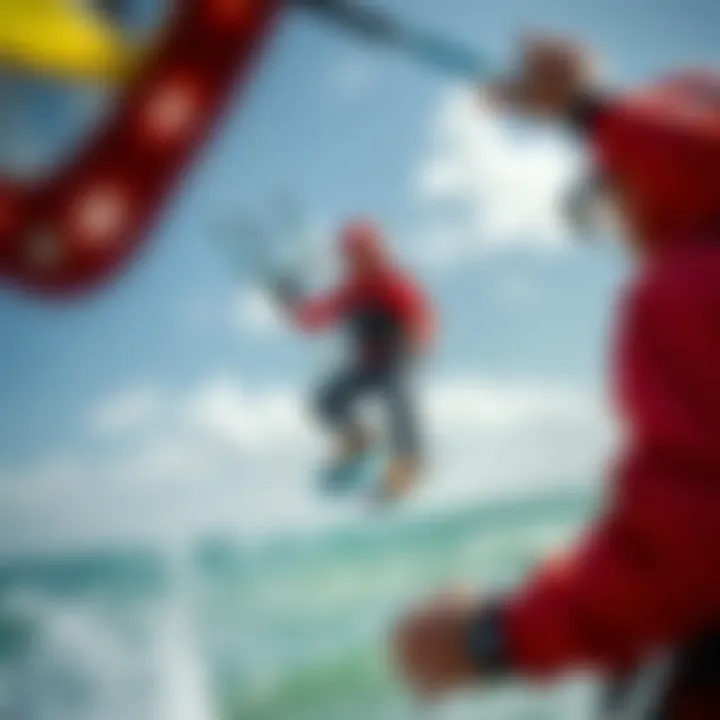
The art of kiteboarding goes way beyond just flying a kite and gliding over water. It demands a deep understanding of techniques that can enhance both performance and safety. Switchblade kites, known for their stability and versatility, offer a range of techniques that can significantly improve a rider's experience. This section explores the essential skills every kiteboarder should master when using switchblade kites, delving into the intricacies that define launching and landing, as well as tricks and maneuvers that can elevate one's performance on the water.
Launching and Landing
Best Practices
When it comes to launching and landing switchblade kites, mastering best practices is the cornerstone of a safe and smooth experience. The technique involves coordinating movements meticulously, so that the kite behaves predictably in the air. A crucial best practice is to align the kite properly against the wind to ensure a smooth lift-off. Additionally, having a buddy assist you can make a world of difference in managing the tension of the lines and the kite itself.
What sets this practice apart is its emphasis on precision. A perfectly executed launch means less chance of entanglements and enhances overall control of the kite, ultimately leading to a more enjoyable ride. The standout feature here is the ability to minimize mishaps by knowing the local wind conditions and having a solid grip on the kite’s position. While it may seem basic, neglecting these elements can lead to awkward situations, especially for beginners or riders in gusty conditions.
Safety Precautions
Safety precautions during launching and landing cannot be overstressed. Each kiteboarder must understand the potential risks involved. A key precaution is keeping a safe distance from other riders and objects, as this mitigates the chances of unwanted accidents. Utilizing a safety release system is also a vital safety feature. It’s designed to depower the kite suddenly in case of emergencies, providing a quick exit strategy when necessary.
One major advantage of following sound safety practices is the increased confidence it gives kiteboarders. By prioritizing safety, riders can focus more on honing their skills rather than worrying about potential dangers. Understanding wind direction and being aware of surroundings can save you from unexpected obstacles, making it a crucial aspect of kiteboarding.
Tricks and Maneuvers
Jumping Techniques
Jumping embodies the thrill of kiteboarding, showcasing the synergy between the kite and rider in an aerial display. With switchblade kites, who are known for their strong lift and stability, executing jumps becomes more accessible. Key jumping techniques include timing your pop with the kite's power zone and utilizing body weight to propel into the air.
Incorporating these techniques allows riders to achieve greater heights and more dynamic aerial maneuvers. A common distinguishing characteristic is the ability of switchblade kites to maintain their shape even when under rigorous use, thus ensuring a stable flight path while airborne. However, jumping does require practice, especially in gauging wind strength and rider technique, as poorly executed jumps can lead to falls or hard landings.
Transitions
Smooth transitions are both art and science; they define a rider’s ability to change direction effortlessly. Manipulating the kite to achieve consistent forward motion allows for a fluid transition during cruising. Key components include leaning into the turn while maintaining tension on the lines. Switchblade kites, with their rigidity, help create seamless transitions as they can quickly redirect power.
The advantage? It keeps the rider on the same path without losing speed, allowing for optimal flow during a ride. The downside is that mastering transitions demands practice and awareness of the balance between kite position and board speed, which can vary significantly in different wind conditions.
Riding Styles
Riding styles can reflect a rider's personality, and switchblade kites cater to various techniques seamlessly, from freeride to freestyle. Each style has its own characteristic movements and execution. For instance, in freestyle riding, the emphasis is on tricks and jumps, while freeride focuses on smooth, continuous motion across the water.
One beneficial aspect of using switchblade kites is their adaptability. Riders can shift effortlessly from one style to another without needing to change kites, making them particularly versatile across different riding scenarios. However, each style challenges a rider’s skills differently, demanding ongoing practice to master specific movements. The beauty is in the exploration – each session can introduce a fresh approach to riding, keeping the experience engaging.
Maintenance and Care for Switchblade Kites
Taking care of your switchblade kite is like tending to a finely-tuned machine—it needs some love and attention to perform at its best. This section looks at the importance of maintenance and proper care for your kite. Ensuring your kite is in good shape not only extends its life but also enhances your overall kiteboarding experience. A kite that's well-maintained responds better to inputs and keeps you safer on the water.
Routine Inspection
Check for Wear and Tear
When you check your kite for wear and tear, you’re assessing how much life it has left to give. Regular inspections can save you from nasty surprises on the water, like a sudden tear during a jump. Key areas to keep an eye on include the seams, leading edge, and canopy fabric. These parts are often where fatigue sets in first because they bear the brunt of inflation and wind pressure.
A good practice is to make this a ritual before every session. Grit your teeth while running your fingers over the fabric to spot any nicks or abrasions. The unique aspect of checking for wear is that it means you can catch issues early, before they become major problems that can jeopardize your safety. Missing this step might lead to greater damage down the line, so don’t skimp on this check!
Proper Storage
Proper storage is another crucial element in kite maintenance. Storing your kite correctly can prevent a host of problems, from mold due to moisture exposure to fabric stretching. The key characteristic here is that when you know how to pack your kite neatly, you’re ensuring it remains in great shape for your next outing.
Ways to store your kite include:
- Deflating it completely to reduce stress on seams.
- Keeping it in a cool, dry place away from sunlight.
The unique feature of proper storage is its preventative nature. Proper packing doesn’t just keep your kite safe; it prolongs its life and ensures you're ready to hit the water without a hitch anytime you're itching for a ride.
Repair Techniques
Even with the best care, accidents happen. Knowing repair techniques can be a game-changer, especially when you're out at the beach. Here are some strategies to tackle repairs.
Common Issues
Common issues with switchblade kites usually include small rips, punctures, and bridle malfunctions. Addressing these on your own can save time and money. If a small tear goes unchecked, it can quickly turn into a larger issue—like a kite that won’t hold air. A keen eye for these small but critical problems makes all the difference.
The critical takeaway here is that being able to identify and proactively address common issues helps maintain your kite’s integrity. Ignoring easy fixes can lead to more complicated scenarios, costing you headaches down the line.
DIY Repairs
When it comes to DIY repairs, having some basic supplies on hand makes you feel like MacGyver on the beach. Whether it’s adhesive patches for small tears or restoring a bridle line with a bit of fishing line, knowing some DIY techniques fosters a sense of self-reliance.
If you're handy, you’ll find a sense of satisfaction that comes with keeping your gear in top shape.
However, it��’s worth noting that while DIY repairs can save you time, there’s a risk of doing it wrong. A makeshift fix could cause more substantial issues down the road, so weigh the pros and cons before you go wild with your toolkit.
Professional Assistance
If your kite has taken a serious hit, seeking professional assistance might be the way to go. Professionals have the skills and tools to perform thorough repairs that you might not be able to do at home. They can address everything from fabric replacement to bridle adjustments.
What sets professional repairs apart is their reliability—knowing that experts are fixing your kite means you're not cutting any corners. But as always, it’s wise to consider the advantages and disadvantages of this route. While possibly pricier, it ensures that your kite is safe and sound, ready for untold adventures.
As you can see, caring for your switchblade kite isn’t just about keeping it clean. It’s a comprehensive approach that involves routine checks, proper storage, and knowing when to repair it yourself or call for help. So, take these tips to heart, and your kite will pay you back in flying colors on the water.
Ending
In discussing the dynamics of switchblade kites, recognizing the implications for the future of kiteboarding is paramount. Various innovations and trends are at play, shaping not only the equipment but also the way enthusiasts engage with the sport. It's important for riders to stay tuned to these evolutions, as they can significantly impact performance, safety, and overall enjoyment.
The Future of Switchblade Kites
Innovations on the Horizon
As technology progresses, the kiteboarding landscape is sure to change. New materials are being explored that promise lighter weight and enhanced durability. Imagine a kite made with a fabric that could withstand extreme conditions yet remain incredibly responsive to user input. That's what many manufacturers are aiming for with these innovations. Such advancements make switchblade kites more accessible to a wider range of skill levels.
Additionally, the integration of smart tech in kites—think sensors that provide real-time feedback on wind conditions or adjustments that can be made directly from the control bar—symbolizes a leap forward. This characteristic not only enhances safety but also gives riders a deeper understanding of their environment.
The adoption of such tech is still new, with its advantages being clear, like improved ride stability and safety features. However, they come with potential drawbacks, like the increased cost and the need for additional maintenance. As such innovations emerge, the choice for kiteboarders will involve weighing the benefits against the complexity and potential expenses.
Trends in Kiteboarding
Observing the current trends is vital for understanding the trajectory of kiteboarding. One notable trend is the growing emphasis on sustainable practices within the industry. More manufacturers are focusing on eco-friendly materials and production practices. These efforts resonate well with environmentally conscious riders, enhancing their overall experience by aligning with their values.
Moreover, there's a notable shift towards increased community engagement. Kiteboarding events are increasingly becoming communal experiences rather than isolated sporting events. Local meet-ups are a breeding ground for tips and tricks, helping improve proficiency while fostering lasting connections among riders.
The unique feature of these trends lies in their ability to adapt to rider demographics. Transitioning towards more community-driven approaches means riders of all skill levels can find camaraderie and growth opportunities. While this evolution has immense benefits, such as shared knowledge and social connections, it may also lead to overcrowding in popular spots, creating challenges for enthusiasts seeking solitude or undisturbed rides.
Overall, the dynamics of switchblade kites will continue shaping the future of kiteboarding, driven by both technological leaps and social shifts. As kiteboarders, keeping an eye on these trends ensures an enriched experience and enables informed choices in an ever-evolving environment.



